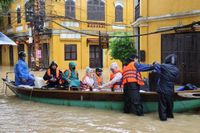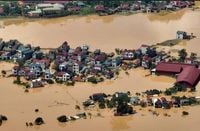Floodwaters have ravaged central Vietnam this week, unleashing a humanitarian and environmental crisis of striking proportions. As of Thursday, October 30, 2025, at least 10 people have been confirmed dead and as many as eight remain missing after days of relentless rain triggered catastrophic floods and landslides across several provinces. The disaster has battered bustling cities, tranquil fields, and vital transport networks, leaving both residents and officials reeling from the scale of the onslaught, according to reports from The Associated Press, AFP, and other major outlets.
Central Vietnam, a region already known for its vulnerability to storms and flooding, has rarely witnessed devastation of this magnitude. The coastal city of Da Nang—often touted as a future growth engine for the nation—has suffered the brunt of the impact. Local authorities reported six deaths and four missing persons in Da Nang alone, with 19 others injured. Homes were swept away, crops destroyed, and thousands of livestock lost to the surging waters. "I don't think I ever experienced this prolonged and terribly high flooding in my life," Da Nang resident Le Thi Thi, 58, told AFP, capturing the disbelief and exhaustion felt by many.
Hue, the former imperial capital and a UNESCO-listed city, has not been spared. One person drowned and a five-year-old girl was reported missing after falling into the floodwaters, according to state media. Much of Hue remains underwater, with rivers overflowing their banks and 32 out of 40 communes submerged. The army mobilized more than 6,000 officers and soldiers to evacuate over 3,200 people from the city, as reported by Vietnam’s civil defence agency. In total, more than 35,000 households in Hue have been affected by the floods.
Hoi An, another UNESCO World Heritage site famed for its ancient town, has also been severely impacted. Photos circulating on state media show houses submerged up to their roofs, with residents forced to paddle boats through what were once bustling streets. The Environment Ministry noted that over 75,000 households in Da Nang and 103,525 houses across the region have been inundated, with water reaching depths of three meters in some areas. The sheer volume of rainfall is staggering—up to 1,085 millimeters (42 inches) in just 24 hours by late Monday, October 27, 2025, setting a new national record, according to the national weather agency.
The disaster’s effects extend far beyond property damage. More than 5,000 hectares of crops have been destroyed, and over 16,000 cattle have perished, according to the Environment Ministry. Roads and bridges have been severely damaged by more than 150 landslides, cutting off access to several communities. In Quang Ngai province alone, at least three people died, and 120 landslides blocked major highways, trapping 50 people in 37 vehicles for three days, as reported by The Associated Press.
Perhaps most alarming is the historic rise of the Thu Bon River, which flows through Da Nang and empties into the sea near Hoi An. The river reached 5.62 meters late Wednesday—four centimeters higher than the previous record set in 1964, the national weather bureau confirmed. This surge inundated the ground floors of homes and shops, leaving residents and business owners facing daunting cleanup and recovery efforts.
Evacuations have been widespread and urgent. Thousands of residents were forced to flee their homes, with authorities deploying police and military forces throughout the affected areas. In some isolated communities, officials in Quang Ngai have begun testing drone deliveries of food and supplies—an innovative but desperate measure as traditional routes remain impassable.
Vietnam’s meteorological agency explained the science behind the disaster: a surge of cool air from the north collided with warm, moisture-rich winds from the sea, setting off a chain of storms that have battered central provinces for days. The mountains acted as a barrier, forcing rain-laden clouds to release even more precipitation. Forecasters warned that this dangerous weather pattern would persist through Thursday night, keeping the ground saturated and the risk of further floods and landslides high.
While some regions have seen floodwaters begin to recede, the situation remains precarious. The weather bureau cautioned that water levels are still at “alarming” heights in many areas, and continued rainfall could exacerbate the crisis. The government’s disaster agency forecasted that certain regions could receive more than 400 millimeters (16 inches) of rain from Wednesday through late Thursday.
The human toll is stark, but the economic cost is also mounting. Vietnam recorded 187 deaths or missing persons due to natural disasters—mainly floods and landslides—in the first nine months of 2025, with economic losses exceeding $610 million, according to government figures cited by AFP and The Associated Press. Officials have warned of mounting losses as rescue and relief efforts continue.
Experts and scientists are sounding the alarm on the role of climate change. Vietnam is among the most flood-prone countries in the world, with nearly half its population living in high-risk areas. Yet the scale and intensity of this week’s floods point to a troubling trend. As AFP reported, "Scientists say human-driven climate change is making extreme weather events such as storms and floods more deadly and destructive." The frequency and severity of such disasters are increasing, and the country’s infrastructure, agriculture, and communities are struggling to keep pace.
Vietnam’s storm season, which runs from June to October, has always brought challenges, but the events of this week have set new benchmarks for devastation. The breached river embankments, isolated neighborhoods, and overwhelmed emergency services underscore the urgent need for adaptation and resilience in the face of a warming planet.
As the waters slowly begin to recede in places like Da Nang and Hue, the full extent of the damage is only starting to emerge. The immediate focus remains on search, rescue, and providing relief to those stranded or displaced. But for many residents, the long road to recovery will be marked by loss, uncertainty, and a growing awareness that such disasters may become all too familiar in the years ahead.
For now, central Vietnam endures, battered but unbowed, as communities come together to face the aftermath of the worst flooding in decades. The lessons learned from this disaster will shape future preparedness and response, but the scars—both physical and emotional—will linger long after the floodwaters have gone.


